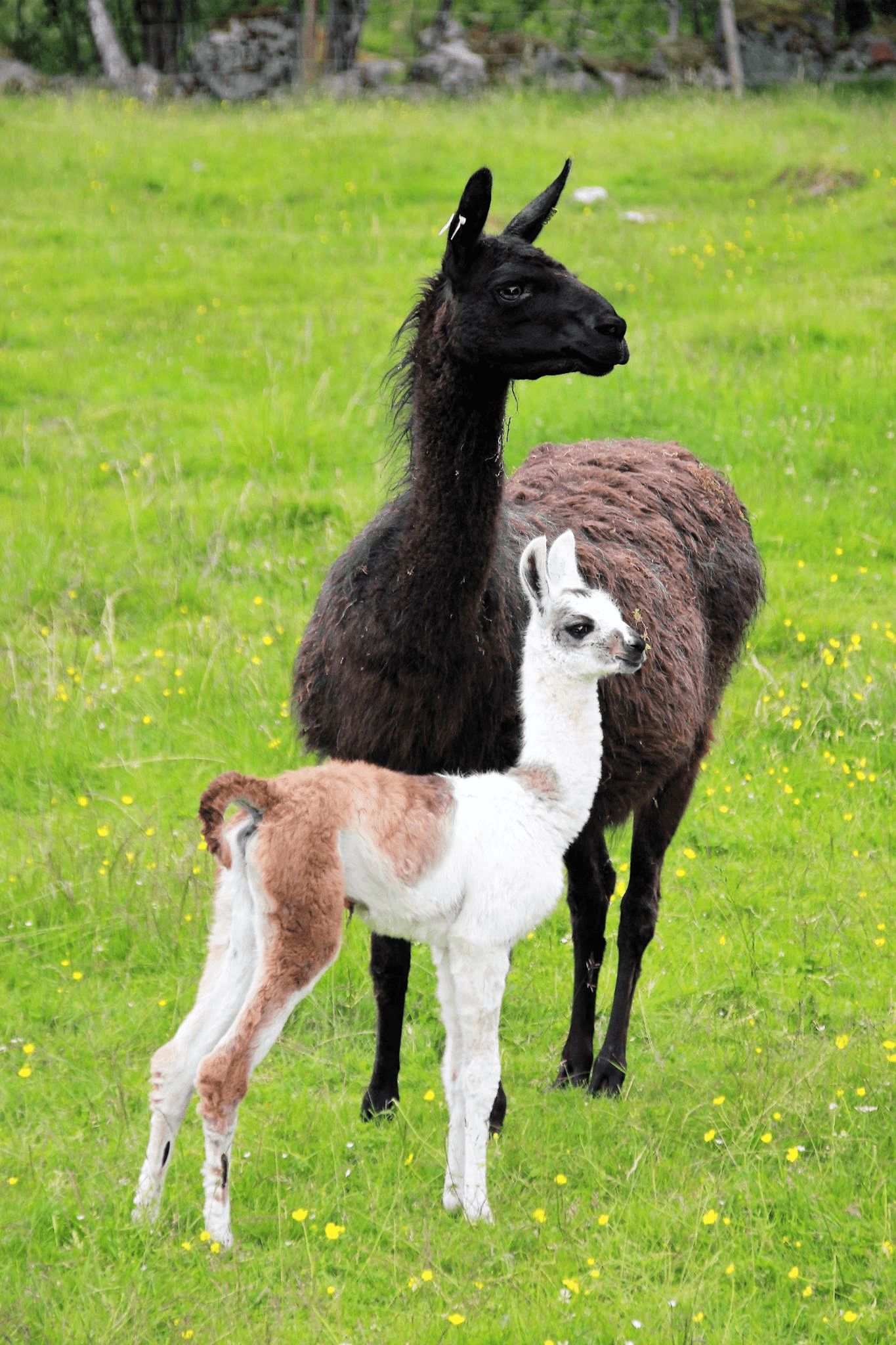What do llamas eat? As herbivores, they eat plants, including grasses, forbs, shrubs, tree leaves and fruit. They thrive in pasture settings and are excellent grazers and browsers. A llama diet staple is hay.
In addition to plants, hay and other vegetation, llamas eat other foods as well. What you feed llamas will depend on why you are raising them. Learn more about this below. You can supplement llama diets with herbivore pellets, salt and limited grains.
Llamas are native to South America, in the high Andes Mountains of Peru and Bolivia which makes them hardy and durable.
What Do Llamas Eat
Llamas are modified ruminant (pseudoruminant) mammals with a 3-chamber stomach. They are similar to ruminants, which have a 4-chamber stomach. They are members of the Camelidae family and related to camels. They regurgitate their food and chew their cud like cattle and sheep do. This aids in digestion and helps them extract more nutrients.
Llamas eat grasses, shrubbery, flowering plants and trees. They will clear the pasture of brush. Their main source of nutrients and energy come from foraging. Forage that provides quality nutrients include: alfalfa, clover, several grass varieties, blackberries, and dandelions.
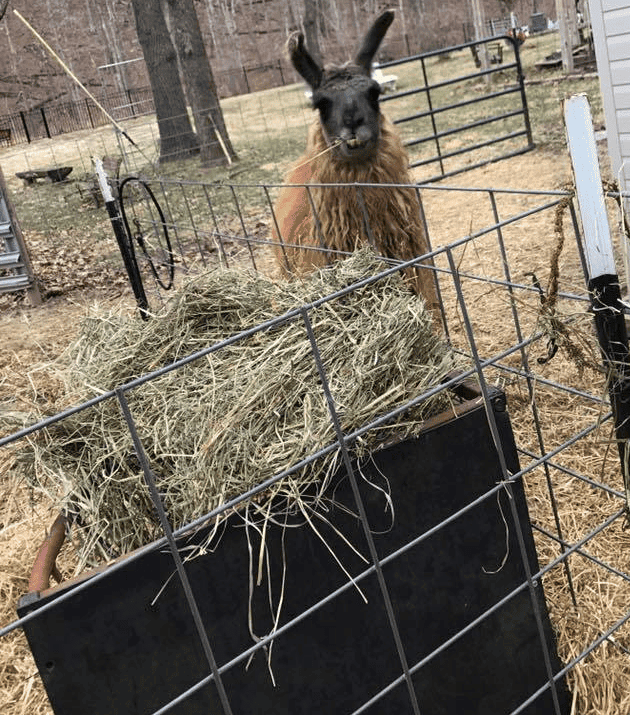
Llamas need Phosphorus and Calcium. In addition, depending on the vegetation they have access to, they can be nutrient deficient in trace metals Copper and Selenium.
When raised on a farm, their diet consists of mostly hay, but you can supplement with grains, especially in the winter months, when foraging may be limited or the hay source is lacking in nutrients. Llamas can also be deficient in Vitamin D in the winter months. Vitamin D can be a year round concern in certain areas — northern United States and Canada — with less intense sun and shorter daylight hours.
Being native to South America, llama ancestors had strong sunlight. It’s important for the baby llamas, crias, to have exposure to Vitamin D as well. When they are born in the fall, crias may not receive sufficient vitamin D in colostrum due to their mother (also called a dam) not receiving enough UV light.
There are many vitamin D supplements on the market. Some can be fed through the diet, while others are injected under the skin. Darker colored llamas may need extra doses.
Becoming overweight is a concern for llamas. Therefore, it’s important to not overfeed them grains. Llamas love treats such as fruits and vegetables and can eat them occasionally. However, a big factor in what llamas eat is their teeth.
Llama Teeth
Like other ruminant animals, in the front of their mouth, llamas have long bottom teeth, but they do not have top teeth. In the back of their mouth, they have top and lower molars which help them grind their food. This grinding of feed is considered pre-digestion before the feed goes into the stomach. Llamas grind feed in their teeth with side to side motions. Unlike humans who chew up and down.
Fresh vegetation is great for llamas since it is moist. This will be easier for the animal to grind up with their teeth compared to dry plants. Hard, dry vegetation or grains will be more difficult for the llama to grind up sufficiently. Llamas that are able graze on nutrient-rich pasture may not need to be supplemented with hay, to maintain their energy.
Popular questions are, Can llamas eat apples? and Can llamas eat carrots? Llamas love carrots and apples. The issue is their teeth. These hard foods can present a choking hazard.
If you feed llamas apples and carrots, they should be cut into small pieces. They will not be able to eat an entire carrot or whole apple because they cannot bite into it. Many experts will say you should not feed llamas apples and carrots. Others will say it is okay to give them to llamas if you chop them up.
The bottom line: When it comes to feeding llamas apples, carrots and other hard fruits and vegetables, it is essential to cut them up so the llama will not choke or struggle to chew it. You can feed these to llamas by hand like a treat.
How Many Llamas Can You Raise Per Acre
Llamas obtain the majority of their nutrients from foraging. Therefore, it is preferred for llamas have grassy pasture and land to forage freely. Each llama will need pasture and/or hay for them to eat up to 2-4% of their body weight per day.
With nutrient-dense vegetation, you can keep 3 – 5 llamas per acre. If vegetation and foliage is not plentiful, keeping 4 – 6 or 7 llamas per two acres may even be too many unless you supplement with hay. Having two acres will enable you to better rotate pasture for llamas. For smaller pastures, it is important to rotate pastures so vegetation can regrow. You can do this with halters — or halter training — if they won’t go on their own.
You will need to ensure the quality of the vegetation and pasture before deciding how many llamas to raise. Foraging provides nutrients and fiber. Plan to supplement llamas’ diets in the colder months.
What Do Llamas Eat in the Winter
A llama diet in the winter will depend on the following:
- How cold and frigid is it? Will the llamas go out in the cold?
- If the llamas can still forage and browse — Is there snow covering the ground?
- If vegetation is able to grow in the cold months
In areas with limited foraging opportunities, you will need to supplement with extra hay. One llama can eat up to 50 pounds of hay a week. This is the equivalent of a small hay bale.
You can supplement with domesticated camelid feed and pellets as well as limited additional grains. As noted above, they can be deficient in Vitamin D and may require supplementation.
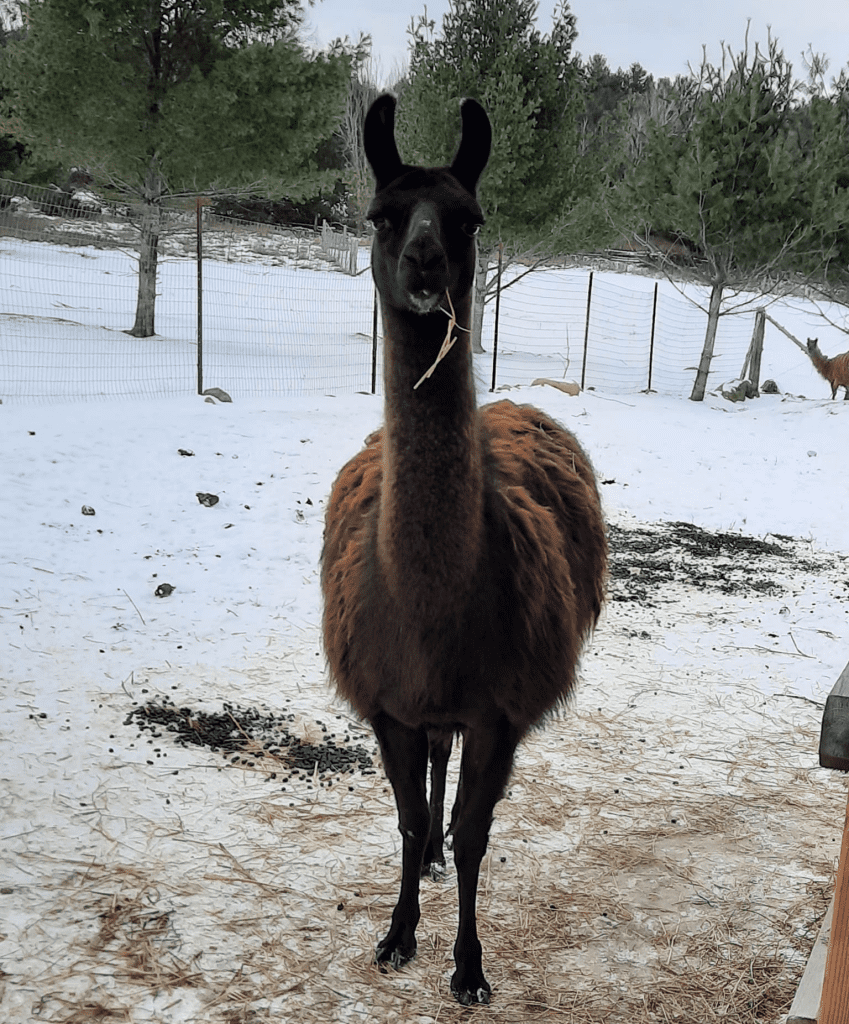
Hay
When raising llamas, supplementing their diets with hay is also essential. It is an easy way to ensure they are getting the important nutrients they need. In the United States, there are several common varieties of hay.
Since llamas are native to more arid areas, they don’t require very high quality roughage. Typically less than 10% protein and greater than 65% dry matter. Timothy hay with a protein level less than 8% and a fiber content of more than 19% is a good choice in food for llamas. It also provides a variety of nutrients, vitamins, and minerals. You can quality test your hay to determine the levels of minerals and see if supplements are required.
Some types of hay to feed llamas are:
Timothy Hay
This is ideal to feed llamas. Timothy hay is high in fiber. It is a high energy, low protein feedstuff. It is easy for livestock such as llamas to digest. While often less expensive than other types of hay, it is used as a filler to help satisfy llamas’ appetites.
It may be easier to find Timothy hay in the cooler climates, in the upper Midwestern states as well as in the Northeast. Llamas eat Timothy hay as well as Timothy legume mixtures.
Orchardgrass
Another good hay to feed llamas is Orchardgrass. This is a high fiber feedstuff with a higher protein content than Timothy hay. It is grown along the coasts in the United States.
Alfalfa Hay
Alfalfa hay is a good protein source for llamas in certain situations. While all llamas will eat it, only growing female llamas as well as pregnant and lactating llamas should eat alfalfa hay. Male llamas and non-pregnant female llamas should not eat alfalfa hay because of the high protein. In addition, it can cause bloating if fed in too high of quantities.
Herbivore Pellets
You can give them herbivore pellets for llamas and alpacas. This is also called camelid feed. Some places that raise llamas in captivity give llamas herbivore biscuits.
Depending on where you live, you can find these at feed stores like Tractor Supply, Runnings, etc. These pellets are often designed to be fed to all classes of llamas, alpacas and sometimes sheep. Though, they will typically be a more costly option.
Grains
Little grain is required in a llama diet. Grains should be only low starch or no starch. Otherwise they will gain weight too quickly. Some examples of grains for llamas diets include:
- Wheat bran
- Wheat middlings
- Soybean hulls
Be sure any grains you feed llamas is made for camelids. They should be ground or processed in some way to make it easier for the llama to chew. Camelid grains should only be supplemented as a small part of the llama diet. The majority of their diet should come from pasture grazing and hay. Grains are filled with protein, which can help supplement gestating or lactating llamas or llamas used as pack animals.
Be aware of grain overload. An abundance of carbohydrates will be difficult to digest; they may ferment instead and cause bloat.
Symptoms to watch out for include diarrhea, dehydration, excessive thirst, bloating on the left side, change in disposition, and more.
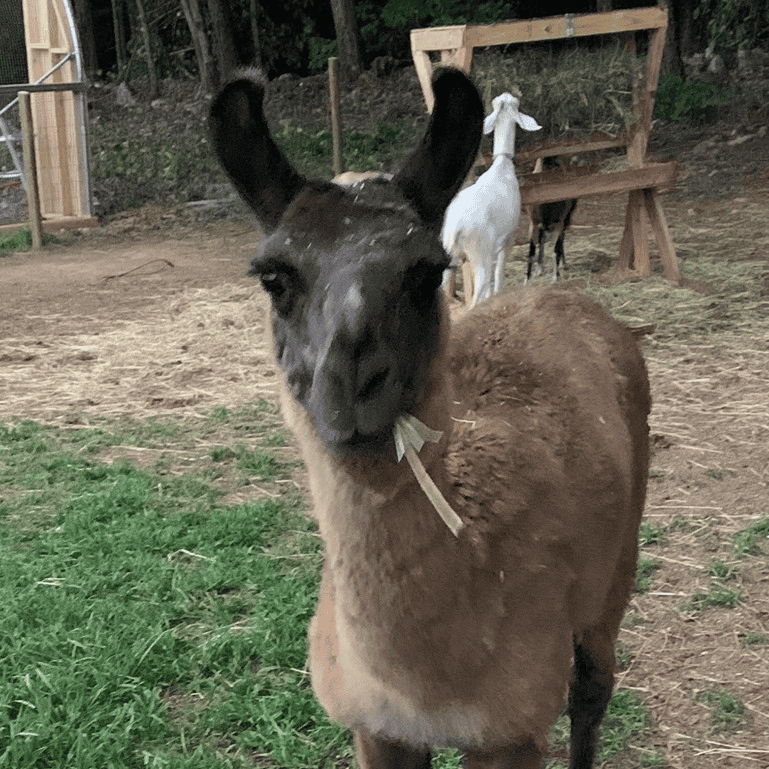
What Treats Can Llamas Eat
Llamas like treats. When giving treats for llamas, give them sparingly, and be sure to chop up harder foods such as sweet potatoes, broccoli, pumpkin, carrots and apples. What do llamas eat for treats? They will love these fruits and veggies:
- Apples
- Carrots
- Sweet potatoes
- Broccoli
- Pineapple
- Blackberries
- Strawberries
- Raspberries
- Watermelon
- Banana
- Pears
- Peaches
- Oranges
- Squash
- Pumpkin
- Grapes
- Celery
- Cantaloupe
- Mango
Fruit sugar can bloat them and cause digestive trouble. Moderation is key.
Do Llamas Need Salt
Llamas will benefit from consuming salt. Free choice salt feeding is best for llamas out on pasture. Placing salt in an area llamas can access it daily will help them ensure they get the salt they need. By offering it as free choice, they will usually only consume what they need and it will prevent them from receiving too much.
Salt blocks and salt licks do not provide enough salt for llamas because llamas do not lick. Therefore, llamas will have the easiest time consuming loose granular salt instead of salt blocks and licks.
Water for Llamas
Llamas will benefit from clean, fresh, accessible water each day. Each llama can drink a gallon a day. As with all animals, access to clean water 24/7 is best.
What Do You Feed a Llama
Llama food needs to include time foraging on pasture. You should also provide llamas hay. The other foods you can feed a llama depend on each llama’s nutritional requirements. Llamas that are gestating, lactating, or under a lot of stress (cold, physical, other) might require supplements.
If you raise llamas to breed and sell them, they will have higher nutrient requirements than if you want them to clear pasture and to raise as a pet or companion animal. Here are some reasons people raise llamas:
- To sell their fiber (wool)
- As pets, companion animals
- Livestock guardian animal
- Clear fields and pasture
- Pack animals
- For their meat
- Breed and sell them
- Show animal for exhibition
Herd supplements can be used to enhance nutrition if the grasses they are foraging aren’t as high in nutrition.
If you want to breed llamas, supplementation will increase their size and help with reproduction, according to Penn State Extension. Many breeders use nutrition as a way to increase fertility.
If you are raising llamas as show animals, you may be advised to supplement with minerals. You may also want to supplement llamas’ food with copper which helps their coats — important if you are selling the fiber and also for exhibition.
Copper can also be important if you are raising llamas for their fibers. However, too much copper can be toxic. Consult your veterinarian if you are interested in supplementing with copper. Loose mineral mixes shouldn’t contain Copper.
What Do Crias Eat
Baby llamas, called crias, will drink milk from their mothers for the first six months. A few weeks after they are born, they will begin foraging and can eat grasses. After they are 6 months old, they eat like adults.
How Much Do Llamas Eat
Llamas eat and require 2 – 4% of their bodyweight in food each day. Llamas can weigh between 250 – 450 pounds. For an adult llama, this can equate to 10 – 12 pounds of food each day. The majority of the diet should consist of forage.
Preventing Choking
In addition to cutting up llama treats, you also need to think about the feed grain. Put the grain in separate areas so the llamas won’t have food competition. They will be able to eat slower. This will help prevent choking and help digestion.
One tip is to layer their grain between hay. You should give llama food (pellets) in shallow troughs or trays. Also have a water source nearby.
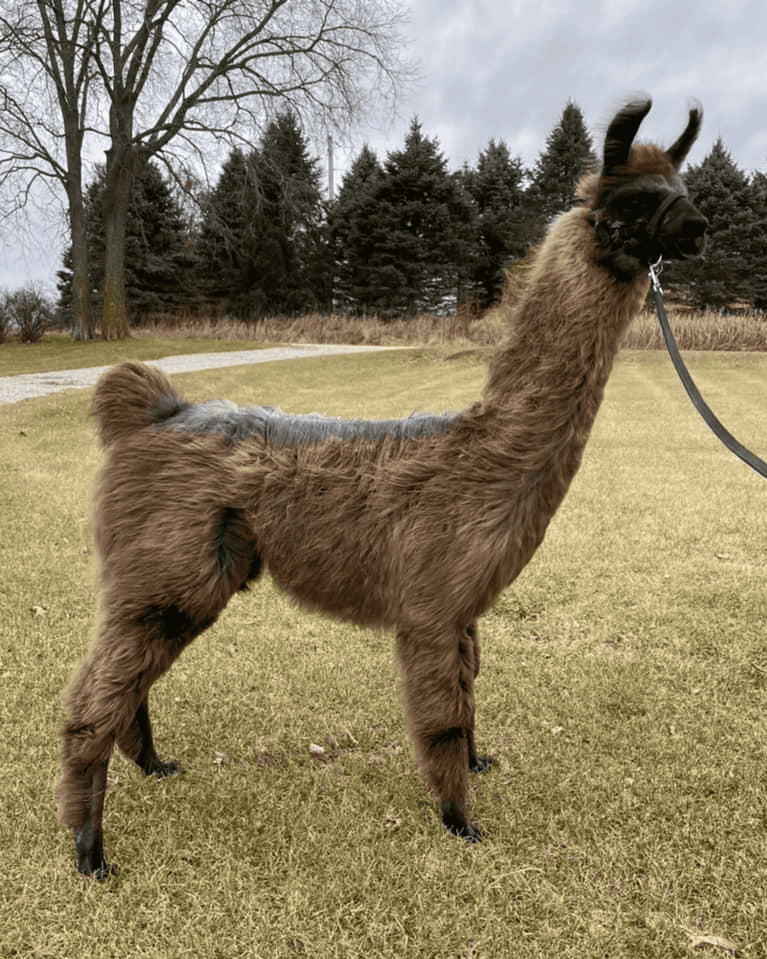
What Can’t Llamas Eat
Llamas will they eat vegetation up to around 6 feet high (from the ground up). You will need to consider what is growing on your property to be sure nothing llamas eat is toxic or harmful. They will eat leaves from trees so it is important to be sure they aren’t poisonous to llamas.
Some examples of foods llamas cannot eat include:
- Plants and grasses that have been sprayed with insecticide and herbicides
- Nightshade foods and nightshade plants and leaves – tomatoes, potatoes, peppers, eggplant
- Cherries
- Wild cherry tree leaves
- Yews
- Azaleas
- Buttercup
- Alfalfa (unless higher protein is required)
FAQs
Do llamas eat grass?
Llamas eat grass and other vegetation. They are herbivores.
Can llamas eat apples?
Llamas can eat apples but you have to cut them small so llamas don’t choke. Llamas have molars but they don’t have other top teeth.
Do llamas eat carrots?
Llamas will love to eat carrots as treats, however, you have to chop them small. Big pieces of carrot can be a choking hazard to llamas.
Do llamas eat meat?
Llamas aren’t designed to digest meat; they are herbivores and eat plants, hay, fruit and vegetables.
Are llamas herbivores?
Llamas are herbivores and thrive when able to freely browse and graze pastures filled with nutrient-dense vegetation.
Do llamas eat hay?
Llamas eat hay. You should supplement a llama diet with hay year round if enough pasture is not available. It is especially important in the colder winter months when they may not be able to graze and forage due to cold temperatures and because of plant dormancy.
What do llamas eat in the wild?
According to National Geographic, llamas are domesticated and no longer live in the wild. When they did, they lived off the land, foraging for grasses, shrubbery, trees, leaves, and plants.
Feeding Llamas on the Farm
A balanced diet with a high quality forage is important for llamas to access for food. Be sure you have enough acreage, usually 3 – 5 llamas for every acre. Rotate them as well. You should also provide fresh water, plenty of hay, and access to salt.
Many llama owners feed them herbivore pellets and herbivore biscuits can contain additional minerals llamas need such as selenium, calcium, and phosphorus. Use fruit as an occasional treat.
Llamas will eat grains in abundance but you need to watch for grain overload. They will gain weight quickly and can easily become obese. In addition, too many carbohydrates will be difficult for llamas to digest and can cause bloat.
In most climates, llamas will forage on plant in the warmer months and eat hay in winter. Llamas shouldn’t eat any plants sprayed with pesticides and herbicides.
Food for Llamas
In conclusion, llamas make a great addition to any farm. Now that you know what do llamas eat, you may realize that having a quality pasture is ideal. They are friendly, easy to care for, and can be trained to do some simple tricks or tasks around the farm. Llamas have been domesticated since the time of the ancient Incans and come in a variety of colors and sizes.
They can be raised as livestock guardian animals, show animals, for their fibers, to breed, as therapy animals, and as pets and recreational animals.
If you’re looking for a new animal to add to your farm, why not try llamas? Llama diets vary depending on location and what is available. They are good at browsing and foraging for their food. It is easy to supplement with hay.
Llamas and alpacas do well together and are among the best farm animals to raise. Learn more about alpaca vs llama.

